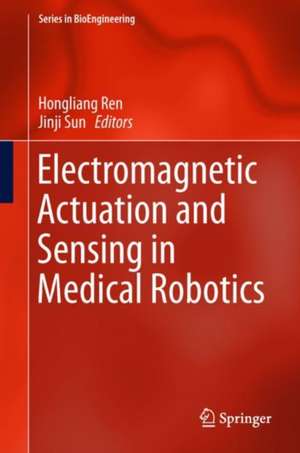Electromagnetic Actuation and Sensing in Medical Robotics: Series in BioEngineering
Editat de Hongliang Ren, Jinji Sunen Limba Engleză Hardback – 20 ian 2018
This book highlights electromagnetic actuation (EMA) and sensing systems for a broad range of applications including targeted drug delivery, drug-release-rate control, catheterization, intravitreal needleless injections, wireless magnetic capsule endoscopy, and micromanipulations. It also reviews the state-of-the-art magnetic actuation and sensing technologies with remotely controlled targets used in biomedicine.
| Toate formatele și edițiile | Preț | Express |
|---|---|---|
| Paperback (1) | 712.09 lei 6-8 săpt. | |
| Springer Nature Singapore – 11 feb 2019 | 712.09 lei 6-8 săpt. | |
| Hardback (1) | 719.02 lei 6-8 săpt. | |
| Springer Nature Singapore – 20 ian 2018 | 719.02 lei 6-8 săpt. |
Din seria Series in BioEngineering
- 15%
 Preț: 576.89 lei
Preț: 576.89 lei - 5%
 Preț: 995.70 lei
Preț: 995.70 lei - 5%
 Preț: 1164.31 lei
Preț: 1164.31 lei - 5%
 Preț: 720.84 lei
Preț: 720.84 lei - 5%
 Preț: 716.45 lei
Preț: 716.45 lei - 15%
 Preț: 643.65 lei
Preț: 643.65 lei - 5%
 Preț: 729.98 lei
Preț: 729.98 lei - 5%
 Preț: 711.88 lei
Preț: 711.88 lei - 5%
 Preț: 1104.48 lei
Preț: 1104.48 lei - 5%
 Preț: 1432.38 lei
Preț: 1432.38 lei - 5%
 Preț: 1413.56 lei
Preț: 1413.56 lei - 5%
 Preț: 1100.09 lei
Preț: 1100.09 lei - 5%
 Preț: 1289.76 lei
Preț: 1289.76 lei - 5%
 Preț: 727.08 lei
Preț: 727.08 lei - 5%
 Preț: 1299.81 lei
Preț: 1299.81 lei - 5%
 Preț: 1166.49 lei
Preț: 1166.49 lei - 5%
 Preț: 724.29 lei
Preț: 724.29 lei - 15%
 Preț: 639.90 lei
Preț: 639.90 lei - 5%
 Preț: 1288.99 lei
Preț: 1288.99 lei - 18%
 Preț: 726.37 lei
Preț: 726.37 lei - 5%
 Preț: 1048.90 lei
Preț: 1048.90 lei - 5%
 Preț: 1164.10 lei
Preț: 1164.10 lei - 5%
 Preț: 1165.40 lei
Preț: 1165.40 lei - 5%
 Preț: 714.46 lei
Preț: 714.46 lei - 5%
 Preț: 1150.98 lei
Preț: 1150.98 lei - 5%
 Preț: 643.87 lei
Preț: 643.87 lei - 5%
 Preț: 1291.57 lei
Preț: 1291.57 lei - 15%
 Preț: 638.57 lei
Preț: 638.57 lei
Preț: 719.02 lei
Preț vechi: 756.86 lei
-5% Nou
Puncte Express: 1079
Preț estimativ în valută:
137.60€ • 143.13$ • 113.60£
137.60€ • 143.13$ • 113.60£
Carte tipărită la comandă
Livrare economică 14-28 aprilie
Preluare comenzi: 021 569.72.76
Specificații
ISBN-13: 9789811060342
ISBN-10: 9811060347
Pagini: 240
Ilustrații: V, 219 p. 133 illus., 83 illus. in color.
Dimensiuni: 155 x 235 mm
Greutate: 0.5 kg
Ediția:1st ed. 2018
Editura: Springer Nature Singapore
Colecția Springer
Seria Series in BioEngineering
Locul publicării:Singapore, Singapore
ISBN-10: 9811060347
Pagini: 240
Ilustrații: V, 219 p. 133 illus., 83 illus. in color.
Dimensiuni: 155 x 235 mm
Greutate: 0.5 kg
Ediția:1st ed. 2018
Editura: Springer Nature Singapore
Colecția Springer
Seria Series in BioEngineering
Locul publicării:Singapore, Singapore
Cuprins
Introduction about the role of EMA/EMS in medicine.- Magnetic Actuated Microparticles with their applications.- Magnetic Actuated Catheterization Robotics (Mesle scale).- Magnetic Actuated Needle-less injectors.- Magnetically suspended manipulators.- Magnetic sensing in surgical robotics.- MRI guided procedures.- Conclusions and future perspectives.
Notă biografică
Dr Hongliang Ren is currently an assistant professor at the Department of Biomedical Engineering, Faculty of Engineering, National University of Singapore (NUS), Singapore, where he leads a research group on Medical Mechatronics. He is an affiliated principal investigator for the Singapore Institute of Neurotechnology (SINAPSE) and Advanced Robotics Center at the National University of Singapore. Dr Ren received his PhD in Electronic Engineering (specialized in Biomedical Engineering) from The Chinese University of Hong Kong (CUHK), Hong Kong SAR in 2008. After graduating, he worked as a research fellow at the Laboratory for Computational Sensing and Robotics (LCSR) and at the Engineering Research Center for Computer-Integrated Surgical Systems and Technology (ERC-CISST), Department of Biomedical Engineering and Department of Computer Science, The Johns Hopkins University, Baltimore, MD, USA, from 2008 to 2010. In 2010, he joined the Pediatric Cardiac Biorobotics Lab, Department ofCardiovascular Surgery, Children's Hospital Boston and Harvard Medical School, USA, where he investigated the beating-heart robotic surgery system. Prior to joining NUS, in 2012 he also worked on a collaborative computer integrated surgery project, at the Surgical Innovation Institute of Children's National Medical Center, USA. His main areas of interest include biomedical mechatronics, computer-integrated surgery, and dynamic positioning in medicine. Dr Jinjin Sun received his B.S. degree from Harbin University of Science and Technology, Harbin, China, in 2001, the M.S. degree from Shandong University, China, in 2004, and the PhD degree from Beihang University, China, in 2010. He is currently an associate professor at the School of Instrument Science and Opto-Electronic Engineering, Beihang University, China. His research interests include the electromagnetic design of various new types of magnetic bearings, such as active magnetic bearings, passive magnetic bearings, hybrid magnetic bearings; brushless direct current motors (BLDCM) and permanent magnet synchronous motors (PMSM). He has been a visiting research fellow with the Department of Biomedical Engineering, National University of Singapore (NUS) since 2015, and he focuses on the research concerning novel magnetic actuations using magnetic levitation techniques.
Textul de pe ultima copertă
This book highlights electromagnetic actuation (EMA) and sensing systems for a broad range of applications including targeted drug delivery, drug-release-rate control, catheterization, intravitreal needleless injections, wireless magnetic capsule endoscopy, and micromanipulations. It also reviews the state-of-the-art magnetic actuation and sensing technologies with remotely controlled targets used in biomedicine.
Caracteristici
Reviews state-of-the-art magnetic actuation and sensing technologies with remotely controlled targets used in biomedicine Highlights the emerging field of magnetic resonance imaging (MRI) guided actuation and sensing procedures Discusses the challenges of electromagnetic actuation (EMA) and sensing systems and its future potential in medical robotics Includes supplementary material: sn.pub/extras
